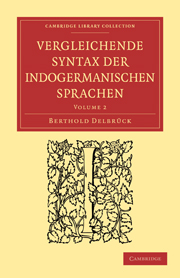Book contents
- Frontmatter
- Vorrede
- Inhaltsangabe
- Abkürzungen
- Kapitel XVI Tempora und Aktionen
- Kapitel XVII Die charakterisierten Präsensbildungen im Altindischen und Griechischen
- Kapitel XVIII Die aus einsilbigen Wurzeln gebildeten Formen (Präsentia und Aoriste)
- Kapitel XIX Die Formen aus Wurzeln auf o (mit o?)
- Kapitel XX Die Verba auf eiō
- Kapitel XXI Die indogermanischen Präsensaktionen im Germanischen und Slavischen
- Kapitel XXII Perfektivierung durch Verbindung mit Präpositionen
- Kapitel XXIII Das Perfektum
- Kapitel XXIV Die Aoriste
- Kapitel XXV Das Futurum
- Kapitel XXVI Mehrere Wurzeln zu einem Verbum vereinigt
- Kapitel XXVII Die Indikative im Arischen und Griechischen
- Kapitel XXVIII Die Indikative im Italischen, Germanischen, Litauischen, Slavisclien
- Kapitel XXIX Die Modi im Arischen und Griechischen
- Kapitel XXX Die Modi in den übrigen Sprachen
- Kapitel XXXI Die Genera Verbi im Arischen und Griechischen
- Kapitel XXXII Die Infinitive
- Kapitel XXXIII Partizipia und Verbaladjektiva
- Kapitel XXXIV Die Partikeln
- Index der Verbalformen
- Sach-Index
- Nachträge und Berichtigungen
Kapitel XXXI - Die Genera Verbi im Arischen und Griechischen
Published online by Cambridge University Press: 05 August 2011
- Frontmatter
- Vorrede
- Inhaltsangabe
- Abkürzungen
- Kapitel XVI Tempora und Aktionen
- Kapitel XVII Die charakterisierten Präsensbildungen im Altindischen und Griechischen
- Kapitel XVIII Die aus einsilbigen Wurzeln gebildeten Formen (Präsentia und Aoriste)
- Kapitel XIX Die Formen aus Wurzeln auf o (mit o?)
- Kapitel XX Die Verba auf eiō
- Kapitel XXI Die indogermanischen Präsensaktionen im Germanischen und Slavischen
- Kapitel XXII Perfektivierung durch Verbindung mit Präpositionen
- Kapitel XXIII Das Perfektum
- Kapitel XXIV Die Aoriste
- Kapitel XXV Das Futurum
- Kapitel XXVI Mehrere Wurzeln zu einem Verbum vereinigt
- Kapitel XXVII Die Indikative im Arischen und Griechischen
- Kapitel XXVIII Die Indikative im Italischen, Germanischen, Litauischen, Slavisclien
- Kapitel XXIX Die Modi im Arischen und Griechischen
- Kapitel XXX Die Modi in den übrigen Sprachen
- Kapitel XXXI Die Genera Verbi im Arischen und Griechischen
- Kapitel XXXII Die Infinitive
- Kapitel XXXIII Partizipia und Verbaladjektiva
- Kapitel XXXIV Die Partikeln
- Index der Verbalformen
- Sach-Index
- Nachträge und Berichtigungen
Summary
Allgemeines
Ich erwähne zunächst die Ansichten der Griechen und der Inder. Die griechische Lehre findet sich zusammengefasst bei Dionysios Thrax, wo es heisst: διαϑέσεις (Lagen des Subjekts, Verhältnisse desselben zur Handlung) εἰσὶ τρεῖς, ἐνέρϒεια, πάϑος, μεσότης ἐνέρϒεια μὲν οἷον τύπτω, πάϑος δὲ οἷον τύπτομαι, μεσότης δὲ ποτὲ μὲν ἐνέρϒειαν ποτὲ δὲ πάϑος παριοτᾶσα, οἷον πέπηϒα, διέφϑορα, ἐποιησάμην, ἐϒραψάμην. Damit ist gesagt, dass es Formen giebt, welche ein Handeln, andere, welche ein Leiden ausdrücken, und als Mittelglied zwischen diesen beiden Extremen solche, welche mit ihrer Form dem einen Gebiet, mit ihrer Bedeutung dem anderen angehören. So sind πέπηγα und διέφϑορα der Form nach aktivisch und der Bedeutung nach passivisch, und mit ἐποιησάμην und ἐγραψάμην verhalt es sich umgekehrt. Eine für sich bestehende besondere Bedeutung wird also dem Medium nicht beigelegt. Das ist auch der Standpunkt des Apollonios, wie überhaupt des Alterthums, wenn auch einige Spuren sich finden, dass der reflexive Sinn des Mediums eikannt worden ist (vgl. Steinthal, 2, 297). Wir verdanken also den Griechen im Grunde nur die Terminologie. Sehr viel weiter sind die Inder gekommen. Die Inder nennen das Aktiv parasmāipada, d. h. die auf einen anderen bezügliche Wortform, das Medium ātmanēpada, d. h. die auf das Subjekt selbst bezügliche Wortform, wobei sie an den Unterschied der zu demselben Verbum gehörigen aktiven und medialen Formen denken, z. B. yájati ʿer opfert für einen anderenʾ, yájati ʿer opfert für sichʾ. Über den Gebrauch lehrt Pāṇini von 1, 3, 12 an Folgendes: An die im Wurzelverzeichnis mit einem bestimmten Zeichen versehenen Wurzeln treten die Medialendungen.
- Type
- Chapter
- Information
- Vergleichende Syntax der indogermanischen Sprachen , pp. 413 - 439Publisher: Cambridge University PressPrint publication year: 2010First published in: 1897



